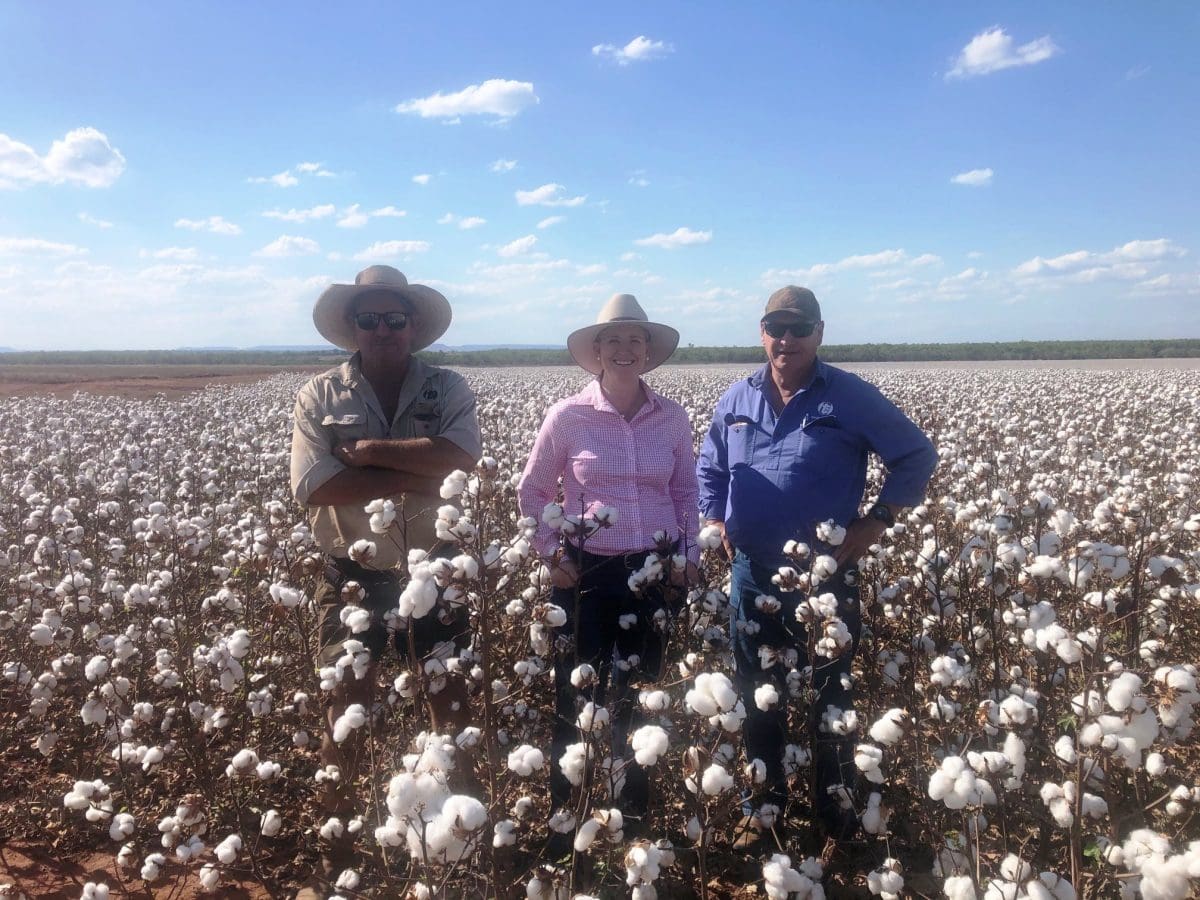
Brothers Bruce and David Connolly in Tipperary Station’s 2021 cotton crop with NT Minister for Agribusiness Nicole Manison. Photo: David Connelly
CONSTRUCTION of the Northern Territory’s first cotton gin is under way, and plans to build a gin in Western Australia’s Ord region are taking shape, as northern Australia’s cotton industry gathers momentum.
However, Queensland Cotton and Southern Cotton’s plans to build the Riverina’s fifth gin as a joint venture appear to be on hold.
Announced in 2018, the gin at Coleambally was initially expected to be operational last year, but a shortage of water limited plantings of the 2019-20 crop, and stymied the near-term demand for increased ginning capacity in southern New South Wales.
Queensland Cotton’s parent Olam and Southern Cotton have been contacted for comment about the Coleambally gin, but are yet to respond.
NT components line up
The NT gin is being built by Western Australia Northern Territory (WANT) Cotton on Tarwoo Station, 35 kilometres north of Katherine.
WANT Cotton chairman and Tipperary Station general manager David Connolly said WANT Cotton had bought 150 hectares from Tarwoo Station, and Sam Buster had been engaged to oversee the building of the gin on the site.
Mr Buster is part of the family which pioneered cotton growing and ginning at Bourke in NSW, and is chief executive officer of RivCott at Carrathool in the Riverina, a grower co-operative which owns and operates Australia’s biggest cotton gin.
RivCott finished ginning for the year in mid-August.
Mr Buster is on site in Katherine for the construction phase.
“Sam has started building the gin shed, and our plan is to start ginning in July-August next year,” Mr Connolly said.
Mr Buster said the gin would incorporate new equipment coming from Lummus in the United States, and second-hand equipment in the form of two eight-foot stands from the mothballed gin at Lake Tandou in south-west NSW.
“It will start off small and it’s designed to be able to grow in stages to become Australia’s largest if and when needed,” Mr Buster said.
Like RivCott, the Katherine gin will be owned by supplying growers, which currently number 10, with room for more to come on board.
“It’s going to be a grower-owned facility, so it will allow the merchants to buy from us without fear or favour,” Mr Connolly said.
In its opening season next year, production of roughly 40,000-45,000 bales is expected, up a little on this year’s production which is being trucked to Queensland for ginning as no closer options exist.
In a Price Waterhouse Coopers study into the feasibility of ginning cotton in northern Australia, the 2019 Ord-NT crop was estimated at 4500 bales from five growers in total.

The NT’s first cotton gin is being built on a 150ha block on Tarwoo Station with frontage to the Stuart Highway. Photo: Elders Real Estate, Katherine
Fillip for cattle
Consolidated Pastoral Company (CPC) CEO Troy Setter said cotton could potentially be grown on two of its properties, Newcastle Waters in the NT and Wrotham Park in north Queensland.
“We’ve planted sorghum on the Barkly, and we put cropping on hold during the 2019-20 drought and because of the challenges with COVID as we focussed on land preparation and development,” Mr Setter said.
With 300,000 cattle spread over seven stations, CPC is one of Australia’s biggest beef producers.
Mr Setter said the company was looking at growing some sustainable irrigated and dryland crops across its portfolio in northern Australia that complemented its core business.
“That could be sorghum or pasture seed or cotton; we’re agnostic.
“We’ve been growing hay in Australia for quite a few years, we planted leucaena several years ago in the Ord, and we’re growing improved pasture and…forage crops.
“If we can add more weight and value to cattle and derisk the business, that will be a plus.”
Mr Connelly is of a similar mind, and said ginning cotton in the NT will give operations like Tipperary the ability to access their own cottonseed as a valuable supplementary feed for cattle.
“People like us got into cotton for fodder reasons.”
Tipperary this year grew around 1500ha of cotton which has been trucked to Dalby on the Darling Downs for ginning.
“At the moment, we’re the biggest grower here, and we’re just feeling our way.”
Mr Connolly said Tipperary was growing corn for silage, as well as hay and sorghum to feed to weaners and grown cattle.
Tipperary is owned by Allan Myers QC and family, and grew its first commercial crop of cotton in 2019, and its second covering 300ha last year.
Opening for Ord
In January, the Western Australian Government pledged $4 million to provide electricity and preliminary design and approval works to a gin the Ord region, where picking of the cotton crop has just finished.
Namoi Cotton, as one of Australia’s biggest ginners, recently announced it had signed a memorandum of understanding with Kimberley Cotton Company (KCC) as part of its strategy to broaden its revenue base.
This points to Namoi being the likely partner for KCC in building WA’s gin.
It will not be WA’s first; the Ord grew and processed cotton in the 1960s, but insect problems and other more viable crops meant the industry’s first iteration did not survive.
Ord cotton grown in recent years has been ginned in Queensland, and may head to Katherine for ginning next year as a closer option if its own gin is not operational.
While NT crops are planted at the start of the wet season in around December, Ord crops are planted in the midst of it in February-March.
NT cotton is picked from roughly June to August, while Ord cotton is picked from August to October.
The quality from both regions is said to be very good, with low moisture and bright colour.
Grain Central: Get our free cropping news straight to your inbox – Click here

HAVE YOUR SAY